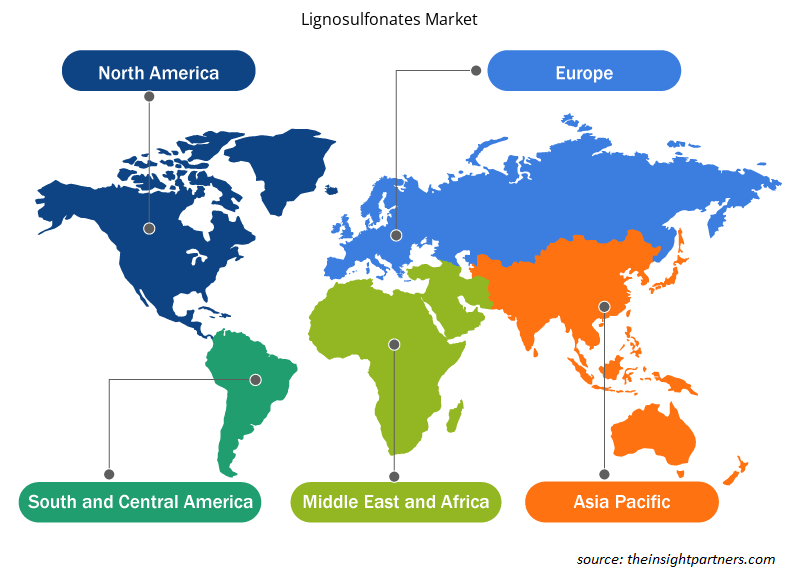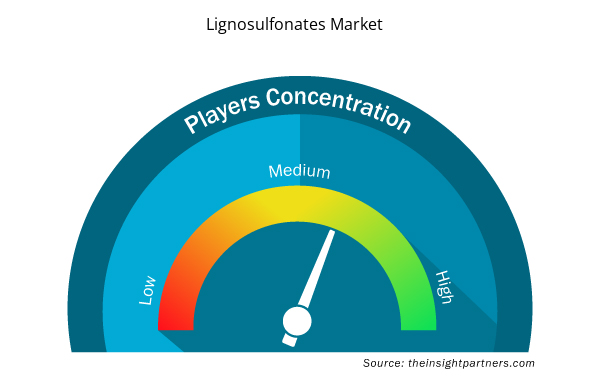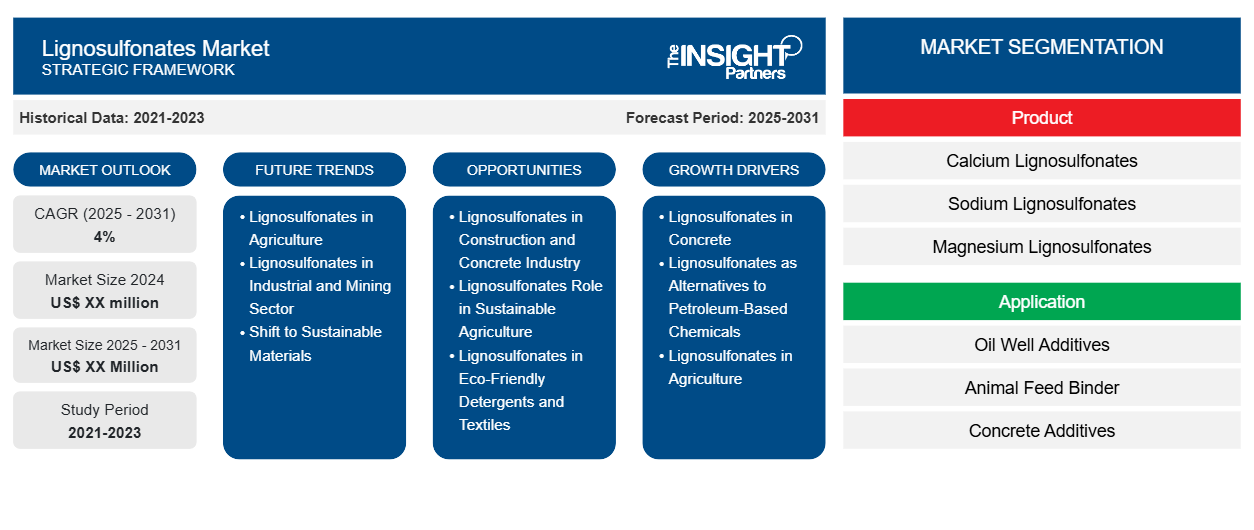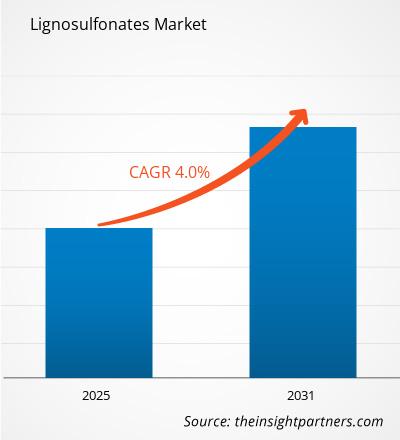Der Markt für Lignosulfonate wird voraussichtlich von 2024 bis 2031 eine durchschnittliche jährliche Wachstumsrate (CAGR) von 4 % verzeichnen, wobei die Marktgröße von XX Millionen US-Dollar im Jahr 2024 auf XX Millionen US-Dollar im Jahr 2031 wachsen wird.
Der Bericht ist nach Produkt segmentiert (Calciumlignosulfonate, Natriumlignosulfonate, Magnesiumlignosulfonate, Sonstige). Die globale Analyse ist weiter auf regionaler Ebene und in die wichtigsten Länder unterteilt. Der Bericht präsentiert außerdem Analysen basierend auf der Anwendung (Ölquellenzusätze, Bindemittel für Tierfutter, Betonzusätze, Staubkontrolle, Sonstige). Die globale Analyse ist weiter auf regionaler Ebene und in die wichtigsten Länder unterteilt. Die Marktgröße und -prognose auf globaler, regionaler und Länderebene für alle wichtigen Marktsegmente werden im Rahmen abgedeckt. Der Bericht bietet den Wert in USD für die oben genannte Analyse und die Segmente. Der Bericht bietet wichtige Statistiken zum Marktstatus der wichtigsten Marktteilnehmer und bietet Markttrends und -chancen.
Zweck des Berichts
Der Bericht „Lignosulfonate Market“ von The Insight Partners zielt darauf ab, die aktuelle Situation und das zukünftige Wachstum sowie die wichtigsten treibenden Faktoren, Herausforderungen und Chancen zu beschreiben. Dies wird verschiedenen Geschäftspartnern Einblicke geben, wie zum Beispiel:
- Technologieanbieter/-hersteller: Um die sich entwickelnde Marktdynamik zu verstehen und die potenziellen Wachstumschancen zu kennen, damit sie fundierte strategische Entscheidungen treffen können.
- Investoren: Durchführung einer umfassenden Trendanalyse hinsichtlich der Marktwachstumsrate, der finanziellen Marktprognosen und der Chancen entlang der Wertschöpfungskette.
- Regulierungsbehörden: Zur Regulierung von Richtlinien und Überwachungsaktivitäten auf dem Markt mit dem Ziel, Missbrauch zu minimieren, das Vertrauen der Anleger zu bewahren und die Integrität und Stabilität des Marktes aufrechtzuerhalten.
Lignosulfonate Marktsegmentierung
Produkt
- Calciumlignosulfonate
- Natriumlignosulfonate
- Magnesiumlignosulfonate
- Sonstiges
Anwendung
- Ölquellenzusätze
- Futtermittelbinder
- Betonzusatzstoffe
- Staubkontrolle
- Sonstiges
Passen Sie diesen Bericht Ihren Anforderungen an
Sie erhalten kostenlose Anpassungen an jedem Bericht, einschließlich Teilen dieses Berichts oder einer Analyse auf Länderebene, eines Excel-Datenpakets sowie tolle Angebote und Rabatte für Start-ups und Universitäten.
- Holen Sie sich die wichtigsten Markttrends aus diesem Bericht.Dieses KOSTENLOSE Beispiel umfasst eine Datenanalyse von Markttrends bis hin zu Schätzungen und Prognosen.
Wachstumstreiber auf dem Markt für Lignosulfonate
- Lignosulfonate in Beton: Lignosulfonate dienen als Dispersionsmittel im Beton, verbessern dessen Fließfähigkeit und reduzieren den Wasserverbrauch. Dieser Trend im Bauwesen, insbesondere in Entwicklungsregionen, führt zu einem steigenden Verbrauch von Lignosulfonaten als umweltfreundlichem und kostengünstigem Zusatzstoff.
- Lignosulfonate als Alternative zu Chemikalien auf Erdölbasis: Lignosulfonate haben in Branchen wie der Landwirtschaft, dem Bauwesen und dem Bergbau anstelle von Chemikalien auf Erdölbasis größere Bedeutung gefunden. Außerdem gibt es Anreize für die Verwendung nicht fossiler Brennstoffe und biologisch abbaubarer Produkte.
- Lignosulfonate in der Landwirtschaft: Lignosulfonate werden in vielen landwirtschaftlichen Arbeiten als Bodenverbesserer und auch als Dispergiermittel eingesetzt. Durch den verbesserten ökologischen Landbau und nachhaltige Techniken ohne Boden ist die Nachfrage nach Lignosulfonaten aufgrund ihrer einzigartigen Möglichkeiten zur Verbesserung von Pflanzen und Böden sehr groß.
Zukünftige Trends auf dem Markt für Lignosulfonate
- Lignosulfonate in der Landwirtschaft: Lignosulfonate werden in der Landwirtschaft häufig verwendet, beispielsweise zur Bodenverbesserung, Dispersion und Benetzung. Die Nachfrage nach ökologischer Landwirtschaft und nachhaltiger Landwirtschaft steigt weltweit, daher wird die Verwendung von Lignosulfonaten aufgrund ihrer Umweltverträglichkeit und Kosten zunehmen.
- Lignosulfonate im Industrie- und Bergbausektor: Im Industrie- und Bergbausektor werden Lignosulfonate seit relativ kurzer Zeit verstärkt als Dispergiermittel eingesetzt, beispielsweise bei der Betonherstellung oder der Produktion und Veredelung von Erzen. Ihr Umweltbewusstsein und ihr Versprechen, die Effizienz von Prozessen zu steigern, motivieren die Industriesektoren, sie zu verwenden.
- Umstellung auf nachhaltige Materialien: Da die Industrie einen Paradigmenwechsel hin zu erneuerbaren und biologisch abbaubaren Ersatzstoffen für Chemikalien auf Erdölbasis vollzieht, besteht ein dringender Bedarf an Gütern wie Lignosulfonaten. Diese Umstellung auf Bauwesen, Landwirtschaft und andere Industrien, die nachhaltige Rohstoffe verwenden, dürfte die Gesamtnachfrage nach Lignosulfonaten auf dem Markt erhöhen.
Marktchancen für Lignosulfonate
- Lignosulfonate in der Bau- und Betonindustrie: Lignosulfonate werden zunehmend als Betondispergiermittel, Fließmittel und Wasserreduzierer eingesetzt. Mit dem Wachstum der Bauindustrie, insbesondere in Schwellenländern, werden Lignosulfonate aufgrund ihrer Kosteneffizienz, Leistung und Umweltfreundlichkeit stärker eingesetzt.
- Rolle der Lignosulfonate in der nachhaltigen Landwirtschaft: Die wachsende Nachfrage nach ökologischer Landwirtschaft und nachhaltiger Landwirtschaft wird zu mehr Möglichkeiten für Lignosulfonate als Bodenverbesserer, Dispergiermittel und Netzmittel führen. Ihre Rolle bei der Verbesserung der Bodenqualität und der Förderung eines gesunden Pflanzenwachstums macht sie zu einer attraktiven Alternative in der Landwirtschaft.
- Lignosulfonate in umweltfreundlichen Waschmitteln und Textilien: Lignosulfonate werden zunehmend als Tenside und Dispergiermittel in Waschmitteln und Textilanwendungen eingesetzt. Angesichts der steigenden Nachfrage nach nachhaltigen und biologisch abbaubaren Wasch- und Reinigungsmitteln bieten Lignosulfonate eine wichtige Chance für umweltfreundliche Produkte.
Regionale Einblicke in den Markt für Lignosulfonate
Die regionalen Trends und Faktoren, die den Markt für Lignosulfonate im Prognosezeitraum beeinflussen, wurden von den Analysten von Insight Partners ausführlich erläutert. In diesem Abschnitt werden auch die Marktsegmente und die Geografie für Lignosulfonate in Nordamerika, Europa, im asiatisch-pazifischen Raum, im Nahen Osten und Afrika sowie in Süd- und Mittelamerika erörtert.

- Erhalten Sie regionale Daten zum Lignosulfonat-Markt
Umfang des Marktberichts zu Lignosulfonaten
| Berichtsattribut | Details |
|---|---|
| Marktgröße im Jahr 2024 | XX Millionen US-Dollar |
| Marktgröße bis 2031 | XX Millionen US-Dollar |
| Globale CAGR (2025 - 2031) | 4 % |
| Historische Daten | 2021-2023 |
| Prognosezeitraum | 2025–2031 |
| Abgedeckte Segmente | Nach Produkt
|
| Abgedeckte Regionen und Länder | Nordamerika
|
| Marktführer und wichtige Unternehmensprofile |
|
Marktteilnehmerdichte für Lignosulfonate: Auswirkungen auf die Geschäftsdynamik verstehen
Der Markt für Lignosulfonate wächst rasant, angetrieben durch die steigende Endverbrauchernachfrage aufgrund von Faktoren wie sich entwickelnden Verbraucherpräferenzen, technologischen Fortschritten und einem größeren Bewusstsein für die Vorteile des Produkts. Mit steigender Nachfrage erweitern Unternehmen ihr Angebot, entwickeln Innovationen, um die Bedürfnisse der Verbraucher zu erfüllen, und nutzen neue Trends, was das Marktwachstum weiter ankurbelt.
Die Marktteilnehmerdichte bezieht sich auf die Verteilung von Firmen oder Unternehmen, die in einem bestimmten Markt oder einer bestimmten Branche tätig sind. Sie gibt an, wie viele Wettbewerber (Marktteilnehmer) in einem bestimmten Marktraum im Verhältnis zu seiner Größe oder seinem gesamten Marktwert präsent sind.
Die wichtigsten auf dem Markt für Lignosulfonate tätigen Unternehmen sind:
- Borregaard
- Burgo-Gruppe
- Domsjö Fabriker AB
- Grüne Agrochemie
- Nippon Paper Industries Co. Ltd
Haftungsausschluss : Die oben aufgeführten Unternehmen sind nicht in einer bestimmten Reihenfolge aufgeführt.

- Überblick über die wichtigsten Akteure auf dem Markt für Lignosulfonate
Wichtige Verkaufsargumente
- Umfassende Abdeckung: Der Bericht deckt die Analyse von Produkten, Dienstleistungen, Typen und Endbenutzern des Lignosulfonate-Marktes umfassend ab und bietet einen ganzheitlichen Überblick.
- Expertenanalyse: Der Bericht basiert auf dem umfassenden Verständnis von Branchenexperten und Analysten.
- Aktuelle Informationen: Der Bericht stellt durch die Abdeckung aktueller Informationen und Datentrends Geschäftsrelevanz sicher.
- Anpassungsoptionen: Dieser Bericht kann angepasst werden, um den spezifischen Kundenanforderungen gerecht zu werden und die Geschäftsstrategien optimal anzupassen.
Der Forschungsbericht zum Markt für Lignosulfonate kann daher dabei helfen, die Branchensituation und Wachstumsaussichten zu entschlüsseln und zu verstehen. Obwohl es einige berechtigte Bedenken geben kann, überwiegen die allgemeinen Vorteile dieses Berichts tendenziell die Nachteile.
- Historische Analyse (2 Jahre), Basisjahr, Prognose (7 Jahre) mit CAGR
- PEST- und SWOT-Analyse
- Marktgröße Wert/Volumen – Global, Regional, Land
- Branche und Wettbewerbsumfeld
- Excel-Datensatz



Report Coverage
Revenue forecast, Company Analysis, Industry landscape, Growth factors, and Trends

Segment Covered
This text is related
to segments covered.

Regional Scope
North America, Europe, Asia Pacific, Middle East & Africa, South & Central America

Country Scope
This text is related
to country scope.
Häufig gestellte Fragen
Rising demand in agriculture is expected to be the key market trends
Based on product, the calcium lignosulfonates segment is expected to witness the fastest growth during the forecast period
Based on geography, Asia Pacific held the largest share of the lignosulfonates market due to the well-established construction industry across the region, coupled with continuous growth and development
Increased demand for concrete admixtures is driving the market growth
Borregaard
; Van Iperen International
; Green Biologics Ltd.
; Sappi Lanaken Mill
; Kemira Oyj
; Domsjö Fabriker
; Biolignin
; Jinan Xingke Biotechnology Co., Ltd.
; Shandong Jinan Xingke Biotechnology Co.
; Foresa
; West Fraser Timber Co. Ltd.
; Ferrostaal GmbH
; Dow Chemical Company
; Advance Lignin Chemical Co., Ltd.
; Abellon CleanEnergy Ltd.
The Lignosulfonates Market is estimated to witness a CAGR of 4% from 2023 to 2031
Trends and growth analysis reports related to Chemicals and Materials : READ MORE..
1. Borregaard
2. Burgo Group
3. Domsjö Fabriker AB
4. Green Agrochem
5. Nippon Paper Industries Co. Ltd
6. Qingdao New World Material Co. Ltd.
7. Sappi Limited
8. Shenyang Xingzhenghe Chemical Co. Ltd
9. Tembec Inc.
10. The Dallas Group of America
The Insight Partners performs research in 4 major stages: Data Collection & Secondary Research, Primary Research, Data Analysis and Data Triangulation & Final Review.
- Data Collection and Secondary Research:
As a market research and consulting firm operating from a decade, we have published and advised several client across the globe. First step for any study will start with an assessment of currently available data and insights from existing reports. Further, historical and current market information is collected from Investor Presentations, Annual Reports, SEC Filings, etc., and other information related to company’s performance and market positioning are gathered from Paid Databases (Factiva, Hoovers, and Reuters) and various other publications available in public domain.
Several associations trade associates, technical forums, institutes, societies and organization are accessed to gain technical as well as market related insights through their publications such as research papers, blogs and press releases related to the studies are referred to get cues about the market. Further, white papers, journals, magazines, and other news articles published in last 3 years are scrutinized and analyzed to understand the current market trends.
- Primary Research:
The primarily interview analysis comprise of data obtained from industry participants interview and answers to survey questions gathered by in-house primary team.
For primary research, interviews are conducted with industry experts/CEOs/Marketing Managers/VPs/Subject Matter Experts from both demand and supply side to get a 360-degree view of the market. The primary team conducts several interviews based on the complexity of the markets to understand the various market trends and dynamics which makes research more credible and precise.
A typical research interview fulfils the following functions:
- Provides first-hand information on the market size, market trends, growth trends, competitive landscape, and outlook
- Validates and strengthens in-house secondary research findings
- Develops the analysis team’s expertise and market understanding
Primary research involves email interactions and telephone interviews for each market, category, segment, and sub-segment across geographies. The participants who typically take part in such a process include, but are not limited to:
- Industry participants: VPs, business development managers, market intelligence managers and national sales managers
- Outside experts: Valuation experts, research analysts and key opinion leaders specializing in the electronics and semiconductor industry.
Below is the breakup of our primary respondents by company, designation, and region:

Once we receive the confirmation from primary research sources or primary respondents, we finalize the base year market estimation and forecast the data as per the macroeconomic and microeconomic factors assessed during data collection.
- Data Analysis:
Once data is validated through both secondary as well as primary respondents, we finalize the market estimations by hypothesis formulation and factor analysis at regional and country level.
- Macro-Economic Factor Analysis:
We analyse macroeconomic indicators such the gross domestic product (GDP), increase in the demand for goods and services across industries, technological advancement, regional economic growth, governmental policies, the influence of COVID-19, PEST analysis, and other aspects. This analysis aids in setting benchmarks for various nations/regions and approximating market splits. Additionally, the general trend of the aforementioned components aid in determining the market's development possibilities.
- Country Level Data:
Various factors that are especially aligned to the country are taken into account to determine the market size for a certain area and country, including the presence of vendors, such as headquarters and offices, the country's GDP, demand patterns, and industry growth. To comprehend the market dynamics for the nation, a number of growth variables, inhibitors, application areas, and current market trends are researched. The aforementioned elements aid in determining the country's overall market's growth potential.
- Company Profile:
The “Table of Contents” is formulated by listing and analyzing more than 25 - 30 companies operating in the market ecosystem across geographies. However, we profile only 10 companies as a standard practice in our syndicate reports. These 10 companies comprise leading, emerging, and regional players. Nonetheless, our analysis is not restricted to the 10 listed companies, we also analyze other companies present in the market to develop a holistic view and understand the prevailing trends. The “Company Profiles” section in the report covers key facts, business description, products & services, financial information, SWOT analysis, and key developments. The financial information presented is extracted from the annual reports and official documents of the publicly listed companies. Upon collecting the information for the sections of respective companies, we verify them via various primary sources and then compile the data in respective company profiles. The company level information helps us in deriving the base number as well as in forecasting the market size.
- Developing Base Number:
Aggregation of sales statistics (2020-2022) and macro-economic factor, and other secondary and primary research insights are utilized to arrive at base number and related market shares for 2022. The data gaps are identified in this step and relevant market data is analyzed, collected from paid primary interviews or databases. On finalizing the base year market size, forecasts are developed on the basis of macro-economic, industry and market growth factors and company level analysis.
- Data Triangulation and Final Review:
The market findings and base year market size calculations are validated from supply as well as demand side. Demand side validations are based on macro-economic factor analysis and benchmarks for respective regions and countries. In case of supply side validations, revenues of major companies are estimated (in case not available) based on industry benchmark, approximate number of employees, product portfolio, and primary interviews revenues are gathered. Further revenue from target product/service segment is assessed to avoid overshooting of market statistics. In case of heavy deviations between supply and demand side values, all thes steps are repeated to achieve synchronization.
We follow an iterative model, wherein we share our research findings with Subject Matter Experts (SME’s) and Key Opinion Leaders (KOLs) until consensus view of the market is not formulated – this model negates any drastic deviation in the opinions of experts. Only validated and universally acceptable research findings are quoted in our reports.
We have important check points that we use to validate our research findings – which we call – data triangulation, where we validate the information, we generate from secondary sources with primary interviews and then we re-validate with our internal data bases and Subject matter experts. This comprehensive model enables us to deliver high quality, reliable data in shortest possible time.


 Holen Sie sich ein kostenloses Muster für diesen Bericht
Holen Sie sich ein kostenloses Muster für diesen Bericht